-

部编人教版六年级上册《七律 · 长征》说课稿
一、说教材《七律·长征》是统编教材小学语文六年级上册第二单元的一篇课文,本课是毛泽东主席在1935年10月,长征即将胜利之时,回想起红军所走过的千山万水,所经历的艰难坎坷,心情激动地写下了这首诗。这首诗生动地概述了红军两万五千里长征的艰难历程,讴歌了中国工农红军在长征途中所表现出的 革命英雄主义气和革命乐观主义精神。 课标对高年级诗歌阅读提出明确要求:“阅读诗歌,大体把握诗意,想象诗歌描述的情境,体会诗人的情感。受到优秀作品的感染和激励,向往和追求美好的理想。”为此,我将本课的教学目标确定如下: 二、说教学目标: (1)知识与能力目标:能正确、流利、有感情地朗读课文,背诵课文,并学习生字,积累词语。 (2)过程与方法目标:借助多媒体课件等资源,创设情境,引领学生自主探究,互动交流,在读中理解,读中感悟。 (3)情感态度与价值观目标:体会红军大无畏的英雄气概和革命乐观主义精神。
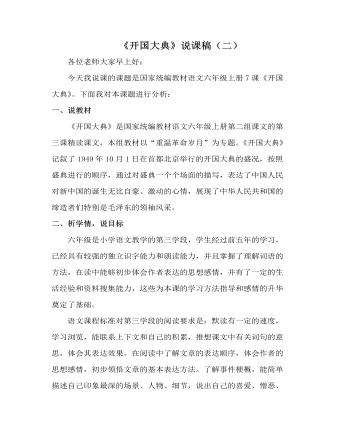
部编人教版六年级上册《开国大典》说课稿(二)
一、说教材《开国大典》是国家统编教材语文六年级上册第二组课文的第三课精读课文,本组教材以“重温革命岁月”为专题。《开国大典》记叙了1949年10月1日在首都北京举行的开国大典的盛况,按照盛典进行的顺序,通过对盛典一个个场面的描写,表达了中国人民对新中国的诞生无比自豪、激动的心情,展现了中华人民共和国的缔造者们特别是毛泽东的领袖风采。二、析学情,说目标六年级是小学语文教学的第三学段,学生经过前五年的学习,已经具有较强的独立识字能力和朗读能力,并且掌握了理解词语的方法,在读中能够初步体会作者表达的思想感情,并有了一定的生活经验和资料搜集能力,这些为本课的学习方法指导和感情的升华奠定了基础。
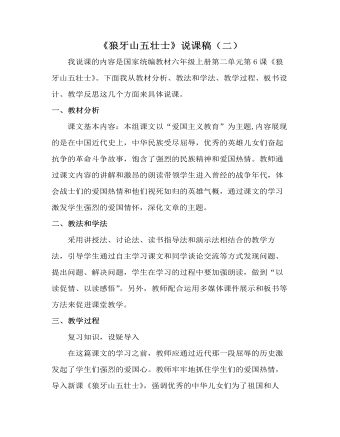
部编人教版六年级上册《狼牙山五壮士》说课稿(二)
一、教材分析课文基本内容:本组课文以“爱国主义教育”为主题,内容展现的是在中国近代史上,中华民族受尽屈辱,优秀的英雄儿女们奋起抗争的革命斗争故事,饱含了强烈的民族精神和爱国热情。教师通过课文内容的讲解和激昂的朗读带领学生进入曾经的战争年代,体会战士们的爱国热情和他们视死如归的英雄气概,通过课文的学习激发学生强烈的爱国情怀,深化文章的主题。二、教法和学法采用讲授法、讨论法、读书指导法和演示法相结合的教学方法,引导学生通过自主学习课文和同学谈论交流等方式发现问题、提出问题、解决问题,学生在学习的过程中要加强朗读,做到“以读促情、以读感悟”。另外,教师配合运用多媒体课件展示和板书等方法来促进课堂教学。
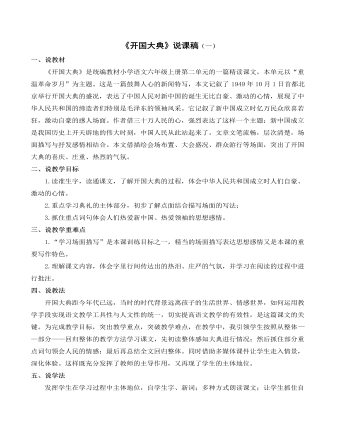
部编人教版六年级上册《开国大典》说课稿(一)
四、说教法 开国大典距今年代已远,当时的时代背景远离孩子的生活世界、情感世界,如何运用教学手段实现语文教学工具性与人文性的统一,切实提高语文教学的有效性,是这篇课文的关键。为完成教学目标,突出教学重点,突破教学难点,在教学中,我引领学生按照从整体——部分——回归整体的教学方法学习课文,先初读整体感知大典进行情况;然后抓住部分重点词句领会人民的情感;最后再总结全文回归整体。同时借助多媒体课件让学生走入情景,深化体验。这样既充分发挥了教师的主导作用,又再现了学生的主体地位。 五、说学法 发挥学生在学习过程中主体地位,自学生字、新词;多种方式朗读课文;让学生抓住自己感兴趣的场景,朗读,想象,谈体会,即通过谈——读——想——体这四个环节,来学习课文,这样既培养了学生的自学能力,又充分发挥了学生的想象力,让学生有效地展开了与文本的对话。
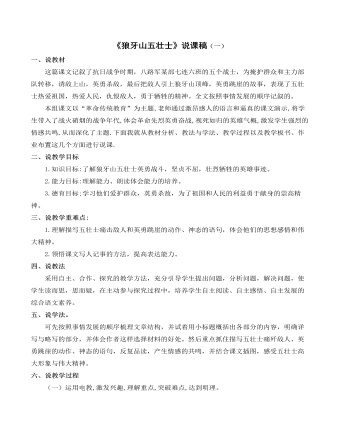
部编人教版六年级上册《狼牙山五壮士》说课稿(一)
一、说教材这篇课文记叙了抗日战争时期,八路军某部七连六班的五个战士,为掩护群众和主力部队转移,诱敌上山,英勇杀敌,最后把敌人引上狼牙山顶峰,英勇跳崖的故事,表现了五壮士热爱祖国,热爱人民,仇恨敌人,勇于牺牲的精神。全文按照事情发展的顺序记叙的。本组课文以“革命传统教育”为主题,老师通过激昂感人的语言和逼真的课文演示,将学生带入了战火硝烟的战争年代,体会革命先烈英勇奋战,视死如归的英雄气概,激发学生强烈的情感共鸣,从而深化了主题.下面我就从教材分析、教法与学法、教学过程以及教学板书、作业布置这几个方面进行说课.二、说教学目标1.知识目标:了解狼牙山五壮士英勇战斗,坚贞不屈,壮烈牺牲的英雄事迹。2.能力目标:理解能力、朗读体会能力的培养。3.德育目标;学习他们爱护群众,英勇杀敌,为了祖国和人民的利益勇于献身的崇高精神。
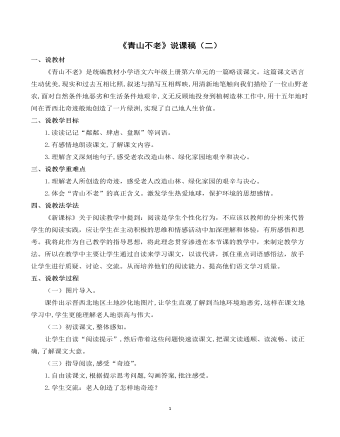
部编人教版六年级上册《青山不老》说课稿(二)
一、说教材 《青山不老》是统编教材小学语文六年级上册第六单元的一篇略读课文。这篇课文语言生动优美,现实和过去互相比照,叙述与描写互相辉映,用清新地笔触向我们描绘了一位山野老农,面对自然条件地恶劣和生活条件地艰辛,义无反顾地投身到植树造林工作中,用十五年地时间在晋西北奇迹般地创造了一片绿洲,实现了自己地人生价值。 二、说教学目标 1.读读记记“粼粼、肆虐、盘踞”等词语。 2.有感情地朗读课文,了解课文内容。 3.理解含义深刻地句子,感受老农改造山林、绿化家园地艰辛和决心。 三、说教学重难点1.理解老人所创造的奇迹,感受老人改造山林、绿化家园的艰辛与决心。 2.体会“青山不老”的真正含义。激发学生热爱地球,保护环境的思想感情。
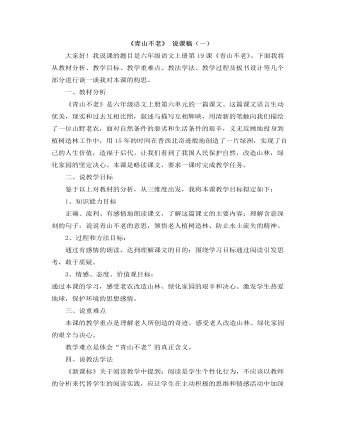
部编人教版六年级上册《青山不老》说课稿(一)
大家好!我说课的题目是六年级语文上册第19课《青山不老》。下面我将从教材分析、教学目标、教学重难点、教法学法、教学过程及板书设计等几个部分进行谈一谈我对本课的构思。一、教材分析 《青山不老》是六年级语文上册第六单元的一篇课文。这篇课文语言生动优美,现实和过去互相比照,叙述与描写互相辉映,用清新的笔触向我们描绘了一位山野老农,面对自然条件的恶劣和生活条件的艰辛,义无反顾地投身到植树造林工作中,用15年的时间在晋西北奇迹般地创造了一片绿洲,实现了自己的人生价值,造福于后代。让我们看到了我国人民保护自然,改造山林,绿化家园的坚定决心。本课是略读课文,要求一课时完成教学任务。
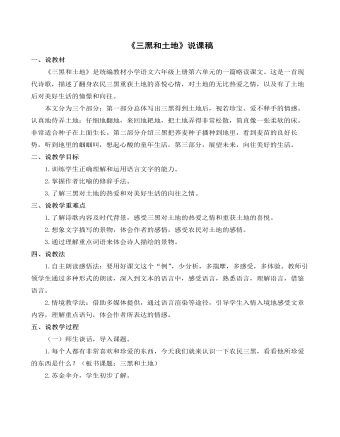
部编人教版六年级上册《三黑和土地》说课稿
一、说教材 《三黑和土地》是统编教材小学语文六年级上册第六单元的一篇略读课文。这是一首现代诗歌,描述了翻身农民三黑重获土地的喜悦心情,对土地的无比热爱之情,以及有了土地后对美好生活的憧憬和向往。 本文分为三个部分:第一部分总体写出三黑得到土地后,视若珍宝、爱不释手的情感。认真地侍弄土地:仔细地翻地,来回地耙地,把土地弄得非常松散,简直像一张柔软的床。非常适合种子在上面生长。第二部分介绍三黑把荞麦种子播种到地里,看到麦苗的良好长势,听到地里的蝈蝈叫,想起心酸的童年生活,第三部分,展望未来,向往美好的生活。 二、说教学目标 1.训练学生正确理解和运用语言文字的能力。 2.掌握作者比喻的修辞手法。 3.了解三黑对土地的热爱和对美好生活的向往之情。
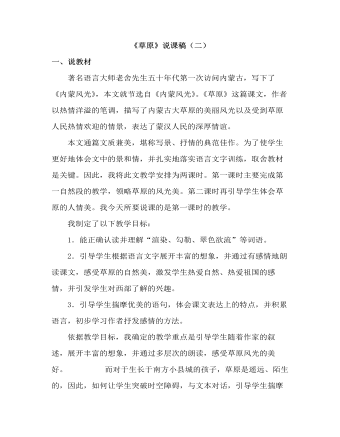
部编人教版六年级上册《草原》说课稿(二)
一、说教材 著名语言大师老舍先生五十年代第一次访问内蒙古,写下了《内蒙风光》,本文就节选自《内蒙风光》。《草原》这篇课文,作者以热情洋溢的笔调,描写了内蒙古大草原的美丽风光以及受到草原人民热情欢迎的情景,表达了蒙汉人民的深厚情谊。 本文通篇文质兼美,堪称写景、抒情的典范佳作。为了使学生更好地体会文中的景和情,并扎实地落实语言文字训练,取舍教材是关键。因此,我将此文教学安排为两课时。第一课时主要完成第一自然段的教学,领略草原的风光美。第二课时再引导学生体会草原的人情美。我今天所要说课的是第一课时的教学。 我制定了以下教学目标: 1.能正确认读并理解“渲染、勾勒、翠色欲流”等词语。 2.引导学生根据语言文字展开丰富的想象,并通过有感情地朗读课文,感受草原的自然美,激发学生热爱自然、热爱祖国的感情,并引发学生对西部了解的兴趣。
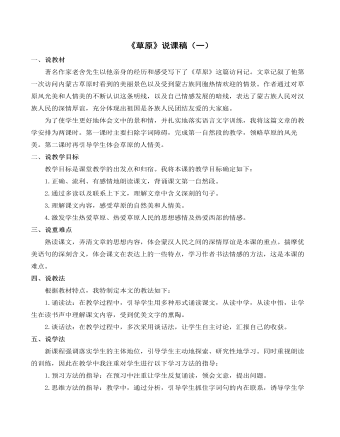
部编人教版六年级上册《草原》说课稿(一)
三、说重难点 熟读课文,弄清文章的思想内容,体会蒙汉人民之间的深情厚谊是本课的重点。揣摩优美语句的深刻含义,体会课文在表达上的一些特点,学习作者书法情感的方法,这是本课的难点。 四、说教法 根据教材特点,我特制定本文的教法如下: 1.诵读法:在教学过程中,引导学生用多种形式诵读课文,从读中学,从读中悟,让学生在读书声中理解课文内容,受到优美文字的熏陶。 2.谈话法:在教学过程中,多次采用谈话法,让学生自主讨论,汇报自己的收获。 五、说学法 新课程强调落实学生的主体地位,引导学生主动地探索、研究性地学习。同时重视朗读的训练,因此在教学中我注重对学生进行以下学习方法的指导: 1.预习方法的指导:在预习中注重让学生反复诵读,领会文意,提出问题。
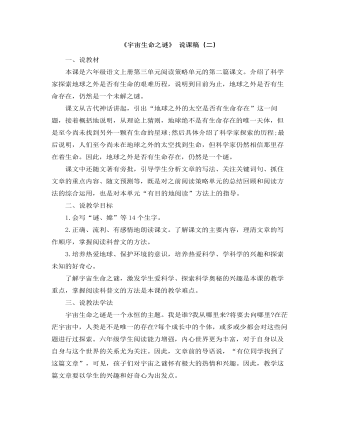
部编人教版六年级上册《宇宙生命之谜》说课稿(二)
三、说教法学法宇宙生命之谜是一个永恒的主题。我是谁?我从哪里来?将要去向哪里?在茫茫宇宙中,人类是不是唯一的存在?每个成长中的个体,或多或少都会对这些问题进行过探索。六年级学生阅读能力增强,内心世界更为丰富,对于自身以及自身与这个世界的关系尤为关注。因此,文章前的导语说,“有位同学找到了这篇文章”,可见,孩子们对宇宙之谜怀有极大的热情和兴趣。因此,教学这篇文章要以学生的兴趣和好奇心为出发点。《语文课程标准》明确指出:“积极倡导自主、合作、探究的学习方式”,要充分发挥学生的主体作用,全面提高学生的语文素养。基于以上认识,我主要采用以读为主,读思议相结合以及引扶放相结合的方法,引入恰当的游戏教学,让学生在把握内容的基础上探究理解,辩论解疑,而教师引导流程,放手让学生自学、探究,点拨重难点,充分发挥学生的主体作用。
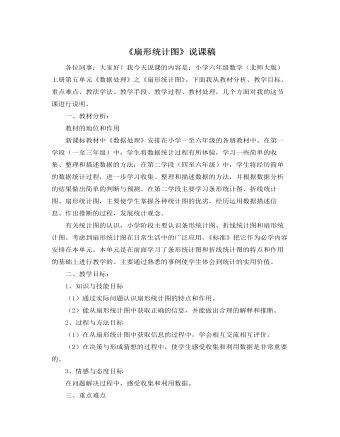
北师大版小学数学六年级上册《扇形统计图》说课稿
一、教材分析:教材的地位和作用新课标教材中《数据处理》安排在小学一至六年级的各册教材中。在第一学段(一至三年级)中,学生将数据统计过程有所体验,学习一些简单的收集、整理和描述数据的方法;在第二学段(四至六年级)中,学生将经历简单的数据统计过程,进一步学习收集、整理和描述数据的方法,并根据数据分析的结果做出简单的判断与预测。在第二学段主要学习条形统计图、折线统计图、扇形统计图,主要使学生掌握各种统计图的优劣,经历运用数据描述信息、作出推断的过程,发展统计观念。有关统计图的认识,小学阶段主要认识条形统计图、折线统计图和扇形统计图。考虑到扇形统计图在日常生活中的广泛应用,《标准》把它作为必学内容安排在本单元。本单元是在前面学习了条形统计图和折线统计图的特点和作用的基础上进行教学的。主要通过熟悉的事例使学生体会到统计的实用价值。
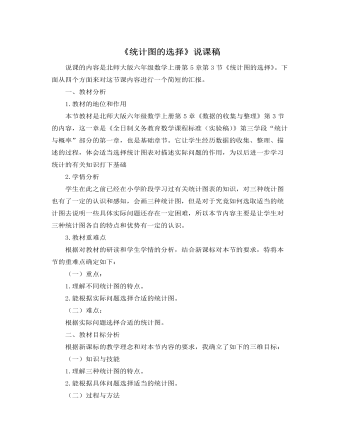
北师大版小学数学六年级上册《统计图的选择》说课稿
一、教材分析1.教材的地位和作用本节教材是北师大版六年级数学上册第5章《数据的收集与整理》第3节的内容,这一章是《全日制义务教育数学课程标准(实验稿)》第三学段“统计与概率”部分的第一章,也是基础章节。它让学生经历数据的收集、整理、描述的过程,体会适当选择统计图表对描述实际问题的作用,为以后进一步学习统计的有关知识打下基础2.学情分析学生在此之前已经在小学阶段学习过有关统计图表的知识,对三种统计图也有了一定的认识和感知,会画三种统计图,但是对于究竟如何选取适当的统计图去说明一些具体实际问题还存在一定困难,所以本节内容主要是让学生对三种统计图各自的特点和优势有一定的认识。3.教材重难点根据对教材的研读和学生学情的分析,结合新课标对本节的要求,特将本节的重难点确定如下:
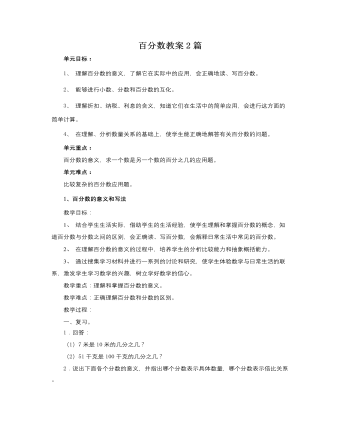
人教版新课标小学数学六年级上册百分数教案2篇
1、完成P78“做一做”第二题:读出下面的分数。2、完成P78“做一做”第一题:直接在书上的横线上写出对应的百分数。3、P79练习十九第4题:读出或写出报栏中的百分数。4、“做一做”第四题:学生根据自己的理解,说说分数和百分数在意义上有何不同。四、布置作业练习十九第1~3题。教学追记:本堂课,我从三个层次入手。第一层:联系生活实际引出百分数;第二层:理解百分数的具体含义;第三层:教学百分数的读写。三个层次,思路清晰,教学层次明显。其中,我把教学重点放在理解百分数的具体含义上,并及时与分数做了比较,教学结构较为严谨。2、百分数和分数、小数的互化教学目标:1、使学生理解并掌握百分数和小数互化的方法,能正确地把分数、小数化成百分数或把百分数化成分数、小数。2、在计算、比较,分析、探索百分数和分数、小数互化的规律的过程中,发展学生的抽象概括能力。3、通过探索百分数和分数、小数互化的规律,激发学生的数学探索意识。
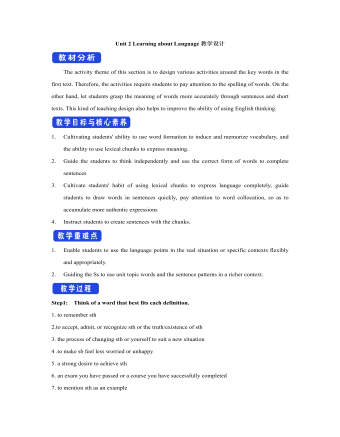
新人教版高中英语选修2Unit 2 Learning about Language教学设计
The activity theme of this section is to design various activities around the key words in the first text. Therefore, the activities require students to pay attention to the spelling of words. On the other hand, let students grasp the meaning of words more accurately through sentences and short texts. This kind of teaching design also helps to improve the ability of using English thinking.1. Cultivating students' ability to use word formation to induce and memorize vocabulary, and the ability to use lexical chunks to express meaning.2. Guide the students to think independently and use the correct form of words to complete sentences3. Cultivate students' habit of using lexical chunks to express language completely, guide students to draw words in sentences quickly, pay attention to word collocation, so as to accumulate more authentic expressions4. Instruct students to create sentences with the chunks.1. Enable students to use the language points in the real situation or specific contexts flexibly and appropriately.2. Guiding the Ss to use unit topic words and the sentence patterns in a richer context.Step1: Think of a word that best fits each definition.1. to remember sth2.to accept, admit, or recognize sth or the truth/existence of sth3. the process of changing sth or yourself to suit a new situation4 .to make sb feel less worried or unhappy5. a strong desire to achieve sth
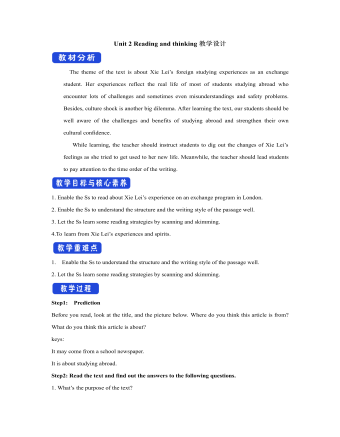
新人教版高中英语选修2Unit 2 Reading and thinking教学设计
Her tutor told her to acknowledge __________ other people had said if she cited their ideas, and advised her _______(read) lots of information in order to form __________wise opinion of her own.Now halfway __________ her exchange year, Xie Lei felt much more at home in the UK. She said __________ (engage) in British culture had helped and that she had been__________ (involve) in social activities. She also said while learning about business, she was acting as a cultural messenger __________(build) a bridge between the two countries. keys:Xie Lei, a 19yearold Chinese student, said goodbye to her family and friends in China and boarded (board) a plane for London six months ago in order to get a business qualification. She was ambitious(ambition) to set up a business after graduation. It was the first time that she had left (leave) home.At first, Xie Lei had to adapt to life in a different country. She chose to live with a host family, who can help with her adaptation (adapt) to the new culture. When she missed home, she felt comforted (comfort) to have a second family. Also Xie Lei had to satisfy academic requirements. Her tutor told her to acknowledge what other people had said if she cited their ideas, and advised her to read lots of information in order to form a wise opinion of her own.Now halfway through her exchange year, Xie Lei felt much more at home in the UK. She said engaging (engage) in British culture had helped and that she had been involved (involve) in social activities. She also said while learning about business, she was acting as a cultural messenger building a bridge between the two countries.
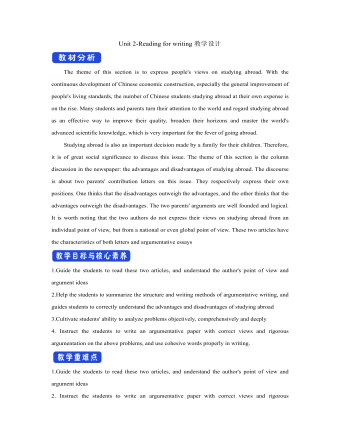
新人教版高中英语选修2Unit 2 Reading for writing教学设计
The theme of this section is to express people's views on studying abroad. With the continuous development of Chinese economic construction, especially the general improvement of people's living standards, the number of Chinese students studying abroad at their own expense is on the rise. Many students and parents turn their attention to the world and regard studying abroad as an effective way to improve their quality, broaden their horizons and master the world's advanced scientific knowledge, which is very important for the fever of going abroad. Studying abroad is also an important decision made by a family for their children. Therefore, it is of great social significance to discuss this issue. The theme of this section is the column discussion in the newspaper: the advantages and disadvantages of studying abroad. The discourse is about two parents' contribution letters on this issue. They respectively express their own positions. One thinks that the disadvantages outweigh the advantages, and the other thinks that the advantages outweigh the disadvantages. The two parents' arguments are well founded and logical. It is worth noting that the two authors do not express their views on studying abroad from an individual point of view, but from a national or even global point of view. These two articles have the characteristics of both letters and argumentative essays1.Guide the students to read these two articles, and understand the author's point of view and argument ideas2.Help the students to summarize the structure and writing methods of argumentative writing, and guides students to correctly understand the advantages and disadvantages of studying abroad3.Cultivate students' ability to analyze problems objectively, comprehensively and deeply
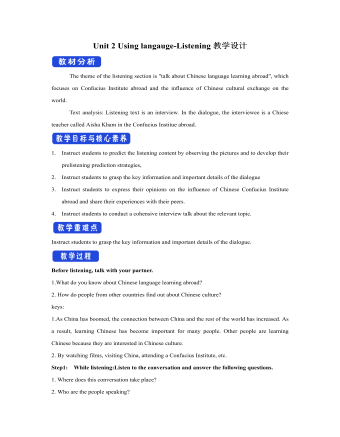
新人教版高中英语选修2Unit 2 Using langauge-Listening教学设计
? B: Absolutely! Getting involved with Chinese cultural activities there definitely helped a lot. I got to practice my Chinese on a daily basis, and I could learn how native Chinese speakers spoke.? A: What do you feel is your biggest achievement?? B: Learning Chinese characters! I have learnt about 1,500 so far. When I first started, I didn't think it was even going to be possible to learn so many, but now I find that I can read signs, menus, and even some easy newspaper articles.? A: What are you most keen on?? B: I've really become keen on learning more about the Chinese culture, in particular Chinese calligraphy. As I have learnt Chinese characters, I have developed a great appreciation for their meaning. I want to explore Chinese characters by learning how to write them in a more beautiful way. ? A: Finally, what do you want to say to anyone interested in learning Chinese?? I have really become keen on learning more about the Chinese culture, in particular Chinese Calligraphy. As I have learnt Chinese character, I have developed a great appreciation for their meaning. I want to explore Chinese characters by learning how to write them in a more beautiful way.? A: Finally, what do you want to say to anyone interested in learning Chinese?? B: I'd say, give it a shot! While some aspects may be difficult, it is quite rewarding and you will be happy that you tried.? A: Thanks for your time. ? B:You're welcome.

新人教版高中英语必修3Unit 2 Morals and Virtues教学设计三
The joke set her crying.这个玩笑使她哭起来。Step 5 ReadingActivity 31. Students read the small text in activity 3. The teacher provides several small questions to check whether students understand the content of the text and the ideographic function of the -ing form in the text.*Where are those people?*Why did Dr Bethune come to China?*How did he help the Chinese people during the war?*What did Chairman Mao Zedong say about him?2. Ss try to rewrite some sentences using the -ing form. Then check the answers. When checking the answers, the teacher can ask different students to read the rewritten sentences and give comments.Answers:1. he became very interested in medicine, deciding to become a doctor.2. …after hearing that many people were dying in the war.3. Helping to organise hospitals, he taught doctors and nurses, and showed people how to give first aid./ He helped to organise hospitals, teaching doctors and nurses, and showing people how to give first aid.4. …praising Dr Bethune as a hero to be remembered in China.Step 6 PracticeActivity 4Students complete grammar activities 2 and 3 on page 69 of the workbook.Step 6 Homework1. Understand and master the functions and usage of the -ing form;2. Finish the other exercises in Using structures.1、通过本节内容学习,学生是否理解和掌握动词-ing形式作宾语补足语语和状语语的功能和意义;2、通过本节内容学习,学生能否正确使用动词-ing形式描述人物的行为、动作及其经历;3、通过本节内容学习,学生能否独立完成练习册和导学案中的相关练习。

新人教版高中英语必修3Unit 2 Morals and virtues教学设计一
(2) students are divided into groups according to the requirements of activity 3. Each student shares a story of personal experience or hearing-witnessing kindness, and then selects the most touching story in the group and shares it with the whole class. Before the students share the story, the teacher can instruct them to use the words and sentence patterns in the box to express. For example, the words in the box can be classified:Time order: first of all, then, after that, later, finally logical relationship :so, however, although, butTeachers can also appropriately add some transitional language to enrich students' expression:Afterwards, afterwards, at last, in the end, eventuallySpatial order: next to, far from, on the left, in front ofOtherwise, nevertheless, as a result, therefore, furthermore, in addition, as well asSummary: in a word, in short, on the whole, to sum up, in briefStep 8 Homework1. Understand the definition of "moral dilemma" and establish a correct moral view;2. Accumulate vocabulary about attitudes and emotions in listening texts and use them to express your own views;3. Complete relevant exercises in the guide plan.1、通过本节内容学习,学生能否理解理解“道德困境”的定义;2、通过本节内容学习,学生能否通过说话人所表达的内容、说话的语气、语调等来判断其态度和情绪;3、通过本节内容学习,学生能否针对具体的道德困境发表自己的看法和见解,能否掌握听力理训练中的听力策略。